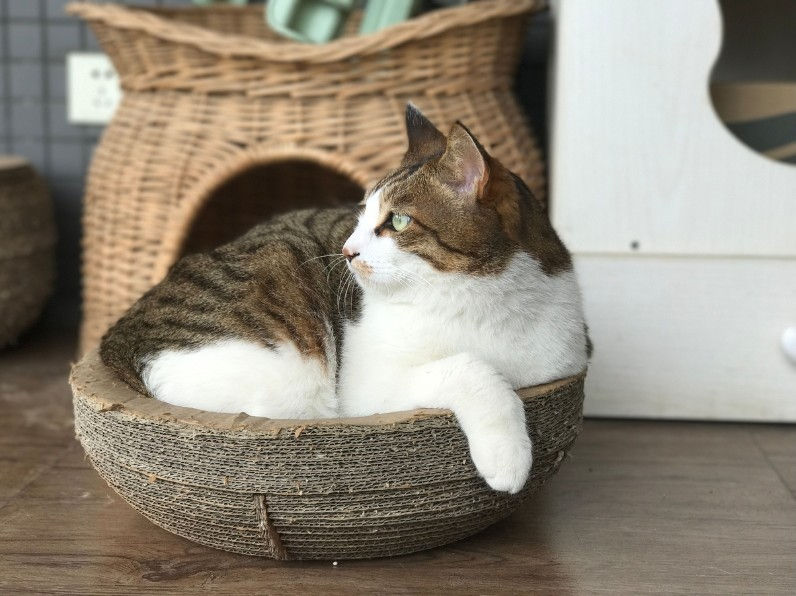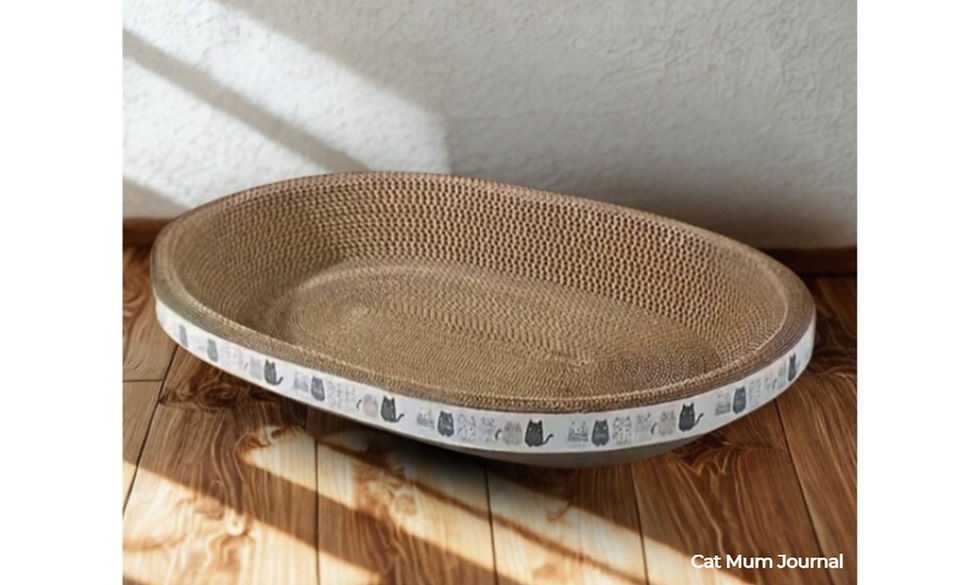Why Do Cats Scratch and How to Stop It?
- Rachel

- Jul 26
- 7 min read
Updated: Nov 6
*As an Amazon Associate I earn from qualifying purchases at no cost to you.

In this article:
Why Do Cats Scratch?
Scratching is a perfectly natural cat behaviour but can quickly become destructive when it involves your carpets, furniture and doing Tarzan impressions on the curtains. To understand this behaviour, we need to look at some of the reasons why cats scratch in the first place.
To stretch their limbs and spine, work their muscles and aid flexibility.
Sharpen and maintain their claws by shedding the outer sheaths.
Scent marking using glands between the pads of their paws to deposit pheromones.
Enrichment.
You might be wondering why domestic cats need to sharpen their claws, since they don't need to defend themselves from predators or capture prey. This survival instinct is deeply embedded into their psychology, and declawing cats for any reason isn't only inhumane but often has severe impacts on their behaviour.
When cats aren't provided with scratching opportunities, they use anything from household items to clothing, shoes, blankets and wallpaper. The problem is more widespread for indoor cats since there are no trees, fences and other hard surfaces. Therefore, cats might be scratching due to a lack of resources; inadequate stimulation; boredom or attention seeking.
More worryingly, scratching can be a coping mechanism for stress and anxiety. Any one of the above examples could be a trigger for stress, but those experiencing chronic stress often have deeper underlying issues.

Stress and Scratching
Signs of acute stress in cats are evident in their body language, such as flattened ears and dilated pupils caused by a loud noise or unfriendly encounter with a stray cat. Chronic or long-term stress usually manifests as behavioural changes. These will vary from cat to cat but may include scratching, urine marking, excessive vocalisation, overgrooming and, in extreme cases, self-mutilation.
Get to know the signs and symptoms of stress in this in-depth article: Signs of Stress in Cats, Causes and Treatment
As mentioned, cats scratch to mark their territorial boundaries, leaving a combination of scent and visual markings to alert other cats. It's wise to pay attention to the location of scratching, particularly in multi-cat homes where competition might be a factor.
Around food and water bowls, litter trays and other resources.
In doorways, halls and narrow spaces where cats are likely to encounter one another.
Near windows, external doors and cat flaps where outside cats might be spotted.
Related post: Where to Put a Cat's Food and Water Bowls, Litter Tray, Bedding and Other Essential Resources

All of these scenarios can indicate territorial insecurity or aggression, particularly if bullying or fighting is present.
Cats also use scent marking to boost comfort and security. With a sense of smell that's fourteen times stronger than a human's, and as their primary form of communication, the slightest whiff of something unfamiliar is going to set off those kitty alarm bells.
Consider all of the smells that are being held in the fabrics of your home. If you've had other cats, pets or people using the same sofa or treading the same carpets over the years, then your kitty's nose is going to be in overdrive. While it's not ideal to replace the entirety of your home, sometimes a thorough clean can make all the difference.
Be sure to use a pet-safe disinfectant or enzymatic cleaner like Simple Solution to remove those stubborn odours.

Reward vs Punishment
Punishing a cat for unwanted behaviours won't solve the problem, but it will make it worse. It's easy for parents to fall into the trap of believing discipline works when kitty stops whatever it's doing or flees whenever you yell the word "no" but this is simply a fear response.
If cats really understood that what they're doing is wrong then why do they keep on doing it? In fact, we can't even describe the behaviour as "wrong" because, from a cat's perspective, all it's doing is what comes naturally.
Yelling at your cat incites fear, and cats react to fear by flight or defensive aggression. This can damage the cat-human relationship, creating distrust and making it even more difficult to retrain them. More importantly, it can elevate a cat's stress levels and the problem escalates.

Cat Scratcher Hammock with a solid wooden frame and comfortable curved design. Features a natural sisal pad that's durable and resistant to fraying. The large size is suitable for scratching and sleeping.
Another mistake, which I've fallen into myself, is rewarding cats for unwanted behaviour, essentially turning a negative into a positive. If you're lifting your cat off the sofa twenty times a day, that's twenty times you're giving them attention that they wouldn't ordinarily be getting were they not engaging in the behaviour. Talk about mixed messages!
Experts agree that the best course of action is to determine the cause and redirect behaviour to a more appropriate outlet, such as scratch posts and mats instead of furniture. Furthermore, using rewards to create positive reinforcement will encourage cats to do more of the desired behaviour.

Types of Scratchers
Thankfully, there are many different types of scratchers available to suit your kitty's preferences, including mats and boards for those that like to scratch horizontal surfaces. If you only have posts in your home then this could be why they prefer to use your nice fluffy carpet.
Here are some options to consider:
Tall, vertical posts with a sturdy base to prevent toppling. Ideally, posts should be a minimum of three feet to allow cats to stretch out their bodies, using both the front and rear claws to climb. You can also get scratch posts with attached toys like feathers and dangly balls.
Cat trees for climbing and exercise.
Sisal mats for horizontal scratchers and carpet destroyers.
Corrugated cardboard scratch boards and baskets. Some of these double up as beds, making them a great multifunctional option.
Need more inspiration? Check out these tried and tested reviews: Cardboard and Sisal Cat Scratcher Reviews (Tried and Tested)

Training Cats to Use a Scratcher
Placement
As obvious as it sounds, you should start by placing scratchers in areas where cats like to scratch. If they're focusing on one particular area of the carpet, cover it with a mat and see if they use that instead. Most cats enjoy a full body stretch after they wake up from a nap, so placing a post near beds or resting areas are also good options.
As mentioned, providing scratching opportunities near external doors and windows allows cats to mark their territory for extra comfort and security. This is also the case for cats that urine spray as it allows another, more hygienic way for cats to scent mark. In multi-cat homes, placing scratchers at entrance and exit points has the same effect.
In theory, you can add as many scratchers around the home as you want. As a bare minimum, you should aim for one scratcher per cat, plus one extra. Keep things interesting by providing a mixture of posts, mats and boards with different textures.

Training
Training cats to use scratchers can be challenging since you need to catch them in the act to be able to move them from the undesired area to the dedicated scratcher. If your cat is tolerant then you can physically place their paws onto the post or mat.
Reward usage with treats, petting or whatever brings your cat the most motivation. This must be done immediately for cats to associate the reward with the desired action.
Consistency is key, whether it takes a week or a month. Over time, you can start reducing rewards as it becomes a natural behaviour.

Cat Scratcher Bed is multifunctional for scratching and napping. Made from high-density corrugated cardboard with a textured surface to maintain claws and withstand vigorous scratching.
If your kitty needs a little more convincing, use these handy tips and tricks:
Sprinkle or spray catnip onto the scratcher to encourage interaction.
Arrange toys around the scratcher to turn it into a play area. You could dangle bits of string or feather wands over it so kitty will catch its claws while swatting and realise, hey, this is kinda fun!
Use your own cat's scent to mark the scratcher as a familiar object, as they'd do naturally when rubbing their faces and lips over furniture and resources. Gently wipe a soft cloth over kitty's cheeks to collect the facial pheromones and rub it onto the scratcher, which they'll detect upon inspection.
Alternatively, you can use a good pheromone spray like Feliway Classic.

Deterrents
There are various products and training aids designed to deter cats from scratching. Double-sided adhesive or anti-scratch tapes will make the area less desirable, and sprays like Woyamay Cat Repellent contain natural scents that cats are averse to.
Scrubbing and washing problem areas will help to get rid of the scent that's already there, making cats less likely to go back to it. If you suspect that stress is a factor, pheromone sprays and diffusers have been clinically proven to reduce many problem behaviours associated with anxiety; however, you shouldn't rely on them without making other changes as described in this article.

Skylos Cardboard Cat House has a 2-tier design for single or multiple use. Cats can lounge on the top or nap inside, and recycled corrugated card provides scratching opportunities on all sides.
Summary
Excessive scratching needs to be addressed, as stress can lead to long-term health issues. It's advisable to speak to a vet who may prescribe medication if any health conditions are discovered or refer you to a behaviourist. This is someone who can help with modifying your environment; behavioural training therapy and other necessary changes.
Lastly, keeping your cat's claws trimmed may help to reduce their need to scratch by promoting shedding of the dead husks so that new, sharper claws can grow naturally. How often trimming is required depends on your cat: those that are young and active with outdoor access will need less maintenance than an inactive indoor cat.
Be sure to use clippers designed for cats, or if you're not comfortable then make an appointment with your local vet.
Recommended Products
Conlun Cardboard Cat House with Scratching Board
Do you have a serial carpet clawer at home? Let us know in the comments if these tips helped!
















Comments